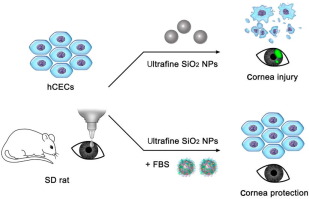Science Bulletin ( IF 18.8 ) Pub Date : 2018-06-08 , DOI: 10.1016/j.scib.2018.05.037 Dayu Sun 1 , Linji Gong 2 , Jing Xie 3 , Xianliang Gu 3 , Yijian Li 3 , Qinglin Cao 3 , Qiyou Li 3 , Luodan A 3 , Zhanjun Gu 2 , Haiwei Xu 3

|
The human cornea is exposed directly to particulate matter (PM) in polluted air. This exposure can cause eye discomfort and corneal injury. Ultrafine PM (diameter <100 nm) is thought to be particularly harmful to health, but there is limited research investigating its toxicity to the eye. In this study, we evaluated toxicity differences among 30-, 40-, 100- and 150-nm silicon dioxide nanoparticles (SiO2 NPs) on the cornea. A 24-hour in vitro exposure of primary human corneal epithelial cells (hCECs) to ultrafine (30 and 40 nm) SiO2 NPs produced toxicity, as evidenced by cell membrane damage, reduced cell viability, increased cell death and mitochondrial dysfunction. In vivo exposure to the same nanoparticles produced observable corneal injury. These effects were more severe with ultrafine than with fine (100 and 150 nm) SiO2 NPs. Common antioxidant compounds, e.g., glutathione, did not protect the cornea from SiO2 NP-induced damage. However, foetal bovine serum (FBS) did significantly reduce toxicity, likely by forming a protective protein corona around the nanoparticles. This finding suggests that FBS (or its derivatives) may be a useful clinical therapy for corneal toxicity caused by ultrafine particulates.
中文翻译:

不同尺寸的二氧化硅纳米粒子对角膜和蛋白冠的毒性作为治疗策略
人的角膜直接暴露于污染空气中的颗粒物 (PM)。这种接触会导致眼睛不适和角膜损伤。超细 PM(直径 <100 nm)被认为对健康特别有害,但调查其对眼睛毒性的研究有限。在这项研究中,我们评估了 30、40、100 和 150 nm 二氧化硅纳米粒子 (SiO 2 NP) 对角膜的毒性差异。原代人角膜上皮细胞 (hCEC) 24 小时体外暴露于超细(30 和 40 纳米)SiO 2NPs 产生毒性,表现为细胞膜损伤、细胞活力降低、细胞死亡增加和线粒体功能障碍。体内暴露于相同的纳米颗粒会产生可观察到的角膜损伤。与细(100 和 150 nm)SiO 2 NP相比,超细 SiO 2 NP 的这些影响更为严重。常见的抗氧化化合物,例如谷胱甘肽,不能保护角膜免受 SiO 2 NP 诱导的损伤。然而,胎牛血清 (FBS) 确实显着降低了毒性,这可能是通过在纳米颗粒周围形成保护性蛋白冠。这一发现表明,FBS(或其衍生物)可能是一种有用的临床疗法,可用于治疗由超细颗粒物引起的角膜毒性。











































 京公网安备 11010802027423号
京公网安备 11010802027423号